Related Research Articles
In many religious, philosophical, and mythological traditions, the soul is the incorporeal essence of a living being. Soul or psyche comprises the mental abilities of a living being: reason, character, feeling, consciousness, qualia, memory, perception, thinking, etc. Depending on the philosophical system, a soul can either be mortal or immortal.
An obelisk is a tall, four-sided, narrow tapering monument which ends in a pyramid-like shape or pyramidion at the top. Originally they were called tekhenu by their builders, the Ancient Egyptians. The Greeks who saw them used the Greek term obeliskos to describe them, and this word passed into Latin and ultimately English. Ancient obelisks are monolithic; that is, they consist of a single stone. Most modern obelisks are made of several stones.

The Xi'an Stele also known as the Nestorian Stele, Nestorian Stone, Nestorian Monument, or Nestorian Tablet, is a Tang Chinese stele erected in 781 that documents 150 years of early Christianity in China. It is a 279 cm tall limestone block with text in both Chinese and Syriac describing the existence of Christian communities in several cities in northern China. It reveals that the initial Church of the East had met recognition by the Tang Emperor Taizong, due to efforts of the Christian missionary Alopen in 635. According to the Stele, Alopen and his fellow Syriac missionaries came to China from Daqin in the ninth year of Emperor Taizong (635), bringing sacred books and images. Buried in 845, probably during religious suppression, the stele was not rediscovered until 1625.
Religions with the belief in a future judgment or a resurrection of the dead or of purgatory often offer prayers on behalf of the dead to God.

A stele, or occasionally stela, when derived from Latin, is a stone or wooden slab, generally taller than it is wide, erected in the ancient world as a monument. The surface of the stele often has text, ornamentation, or both. These may be inscribed, carved in relief, or painted.

The Tel Dan Stele is a fragmentary stele containing a Canaanite inscription, discovered in 1993 in Tel-Dan by Gila Cook, a member of an archaeological team lead by Avraham Biran, the pieces having been used to construct an ancient stone wall that survived into modern times. The stele is in several pieces and contains several lines of Aramaic, closely related to Hebrew and historically a common language among Jews. The surviving inscription, which dates to 9th century BCE, details that an individual killed Jehoram, the son of Ahab, king of Israel and the king of the house of David. These writings corroborate passages from the Bible, as the Second Book of Kings mentions that Jehoram, also Joram, is the son of an Israelite king, Ahab, by his Phoenician wife, Jezebel. Applying a Biblical viewpoint to the inscription, the likely candidate for having erected the stele is Hazael, an Aramean king, whose language would have been Aramaic, who is mentioned in Second Book of Kings as having conquered the Land of Israel, though he was unable to take Jerusalem. The stele is currently on display at the Israel Museum, and is known as KAI 310.

Mỹ Sơn is a cluster of abandoned and partially ruined Hindu temples in Quảng Nam province, central Vietnam, constructed between the 4th and the 14th century by the Kings of Champa, an Indianized kingdom of the Cham people. The temples are dedicated to the worship of the god Shiva, known under various local names, the most important of which is Bhadreshvara.
A nefesh is a Semitic monument placed near a grave so as to be seen from afar.

Sam'al, also Zincirli Höyük, is an archaeological site located in the Anti-Taurus Mountains of modern Turkey's Gaziantep Province. It was founded at least as far back as the Early Bronze Age and thrived between 3000 and 2000 BCE, and on the highest part of the upper mound was found a walled citadel of the Middle Bronze Age. New excavations revealed a monumental complex in the Middle Bronze Age II, and another complex that was destroyed in the mid to late 17th century BCE, maybe by Hititte king Hattusili I. It was largely abandoned during the Hittite and Mitanni periods but flourished again in the Iron Age, initially under Luwian-speaking Neo-Hittites, and by 920 BCE had become a kingdom. In the 9th and 8th century BC it came under control of the Neo-Assyrian Empire and by the 7th century BC had become a directly ruled Assyrian province.
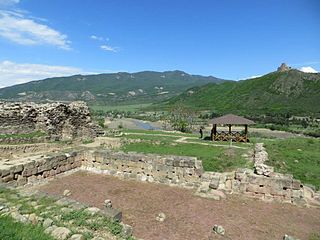
Armazi is a locale in Georgia, 4 km southwest of Mtskheta and 22 km northwest of Tbilisi. A part of historical Greater Mtskheta, it is a place where the ancient city of the same name and the original capital of the early Georgian kingdom of Kartli or Iberia was located. It particularly flourished in the early centuries CE and was destroyed by the Arab invasion in the 730s.
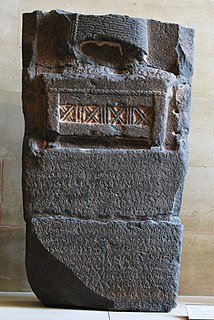
The Stele of Zakkur is a royal stele of King Zakkur of Hamath and Luhuti in the province Nuhašše of Syria, who ruled around 785 BC.
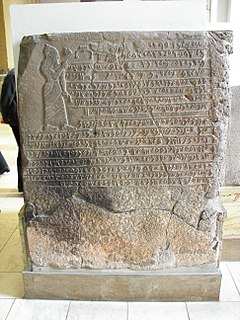
The Kilamuwa Stele is a 9th-century BC stele of King Kilamuwa, from the Kingdom of Ya'diya. He claims to have succeeded where his ancestors had failed, in providing for his kingdom. The inscription is known as KAI 24.

Bixi, or Bi Xi, is a figure from Chinese mythology. One of the 9 sons of the Dragon King, he is depicted as a dragon with the shell of a turtle. Stone sculptures of Bixi have been used in Chinese culture for centuries as a decorative plinth for commemorative steles and tablets, particularly in the funerary complexes of its later emperors and to commemorate important events, such as an imperial visit or the anniversary of a World War II victory. They are also used at the bases of bridges and archways. Sculptures of Bixi are traditionally rubbed for good luck, which can cause conservation issues. They can be found throughout East Asia in Japan, Korea, Vietnam, Mongolia, and even the Russian Far East.
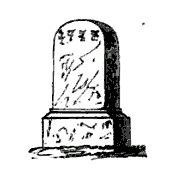
The Yongning Temple Stele is a Ming Dynasty stele with a trilingual inscription that was erected in 1413 to commemorate the founding of the Yongning Temple (永寕寺) in the Nurgan outpost, near the mouth of the Amur River, by the eunuch Yishiha. The location of the temple is the village of Tyr near Nikolayevsk-on-Amur in Russia. This stele is renowned both as the latest known example of a monumental inscription in the Jurchen script, and also for the inscription of the Buddhist mantra Om mani padme hum in four different scripts on its sides. A stele with a monolingual Chinese inscription, commemorating the repair of the temple by Yishiha, was erected in 1433. Both monuments are now held at the Arsenyev Museum in Vladivostok.

Ancient Greek funerary practices are attested widely in the literature, the archaeological record, and the art of ancient Greece. Finds associated with burials are an important source for ancient Greek culture, though Greek funerals are not as well documented as those of the ancient Romans.
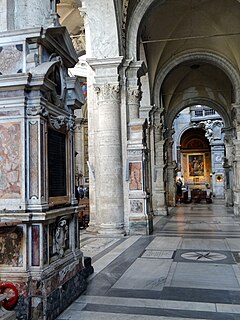
Monuments in the Basilica of Santa Maria del Popolo are tombs and funerary monuments ranging from the 15th to the 19th centuries. Since its rebuilding in the 1470s by Pope Sixtus IV the Basilica of Santa Maria del Popolo was one of the favourite burial places for members of the papal aristocracy, clergy and literati. Foreign artists were also buried in the church due to its location near their favourite quarter in Rione Campo Marzio. The high number of tombs and monuments makes the basilica a whole museum of sculpture as Jacob Burckhardt phrased it in his famous guide of Italian art in 1855. Besides the tombs in the side chapels and the choir there are many other funeral monuments in the aisles and the transept. During the centuries several monuments were demolished and others were relocated to give place to newer ones.

The Grave Stele of Dexileos, is the stele of the tomb of an Athenian cavalryman named Dexileos who died in the Corinthian War against Sparta in 394 BC. The stele is attributed to “The Dexileos Sculptor”. Its creation can be dated to 394 BC, based on the inscription on its bottom, which provides the dates of birth and death of Dexileos. The stele is made out of an expensive variety of Pentelic marble and is 1.86 metres tall. It includes a high relief sculpture depicting a battle scene with an inscription below it. The stele was discovered in 1863 AD in the family plot of Dexileos at the Dipylon cemetery in Kerameikos, Athens. It was found in situ, but was moved during World War II and is now on display in the Kerameikos Museum in Athens.

The Melqart stele, also known as the Ben-Hadad or Bir-Hadad stele is an Aramaic stele which was created during the 9th century BCE and was discovered in 1939 in Syria. The Old Aramaic inscription is known as KAI 201; its five lines reads:
“The stele which Bir-Hadad, son of ‘Ezer, the Damascene, son of the king of Aram, erected to his Lord Melqart, to whom he made a vow and who heard his voice.”

The Canaanite and Aramaic inscriptions, also known as Northwest Semitic inscriptions, are the primary extra-Biblical source for understanding of the society and history of the Ancient Hebrews, Phoenicians and Aramean people. Semitic inscriptions may occur on stone slabs, pottery ostraca, ornaments, and range from simple names to full texts. The older inscriptions form a Canaanite-Aramaic dialect continuum, exemplified by writings which scholars have struggled to fit into either category, such as the Stele of Zakkur and the Deir Alla Inscription.

The Kuttamuwa stele is an 800-pound basalt funerary stele with an Aramaic inscription referring to Kuttamuwa, an 8th-century BC royal official. It was found in Sam'al, in southeastern Turkey, in 2008, by the Neubauer Expedition of the Oriental Institute at the University of Chicago.
References
- ↑ "Found: An Ancient Monument to the Soul". New York Times . November 17, 2008. Retrieved 2008-11-18.
In a mountainous kingdom in what is now southeastern Turkey, there lived in the eighth century B.C. a royal official, Kuttamuwa, who oversaw the completion of an inscribed stone monument, or stele, to be erected upon his death. The words instructed mourners to commemorate his life and afterlife with feasts “for my soul that is in this stele.”